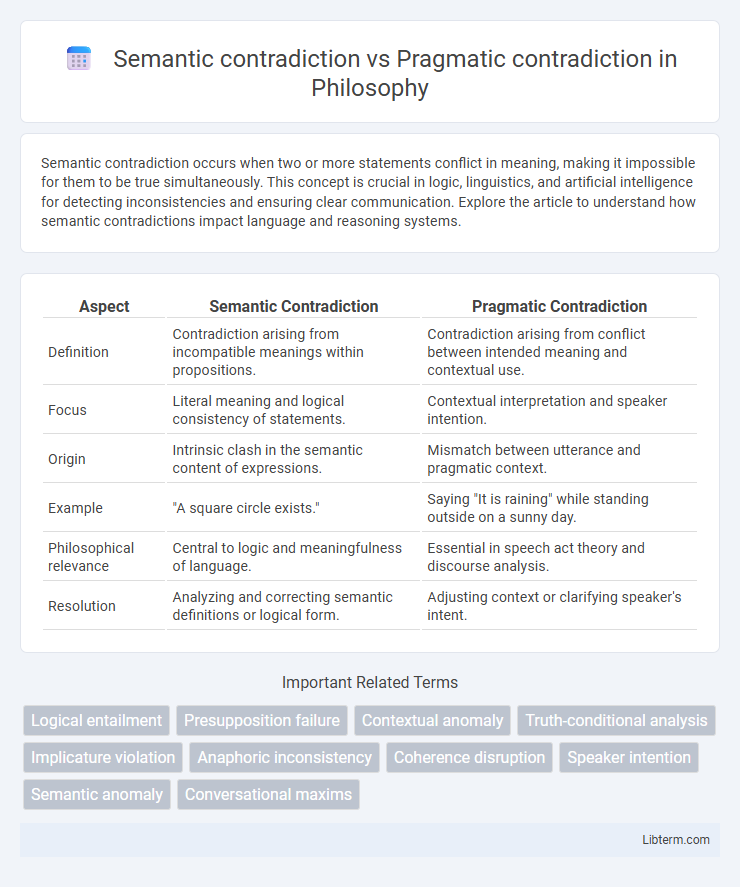Semantic contradiction occurs when two or more statements conflict in meaning, making it impossible for them to be true simultaneously. This concept is crucial in logic, linguistics, and artificial intelligence for detecting inconsistencies and ensuring clear communication. Explore the article to understand how semantic contradictions impact language and reasoning systems.
Table of Comparison
| Aspect | Semantic Contradiction | Pragmatic Contradiction |
|---|---|---|
| Definition | Contradiction arising from incompatible meanings within propositions. | Contradiction arising from conflict between intended meaning and contextual use. |
| Focus | Literal meaning and logical consistency of statements. | Contextual interpretation and speaker intention. |
| Origin | Intrinsic clash in the semantic content of expressions. | Mismatch between utterance and pragmatic context. |
| Example | "A square circle exists." | Saying "It is raining" while standing outside on a sunny day. |
| Philosophical relevance | Central to logic and meaningfulness of language. | Essential in speech act theory and discourse analysis. |
| Resolution | Analyzing and correcting semantic definitions or logical form. | Adjusting context or clarifying speaker's intent. |
Introduction to Semantic and Pragmatic Contradiction
Semantic contradiction occurs when statements logically negate each other within their inherent meaning, such as "The cat is black" versus "The cat is not black." Pragmatic contradiction arises from contextual or situational factors affecting interpretation, for example, a promise conflicting with a speaker's known intentions or circumstances. Understanding these contrasts highlights how meaning is constructed through both linguistic content and communicative context.
Defining Semantic Contradiction
Semantic contradiction occurs when two statements inherently oppose each other based on their meanings, making it impossible for both to be true simultaneously. This type of contradiction relies on the internal logic of language, such as the statement "The circle is square," which conflicts due to the incompatible definitions of "circle" and "square." Understanding semantic contradiction is crucial for analyzing logical consistency in linguistics and formal semantics.
Understanding Pragmatic Contradiction
Pragmatic contradiction arises when the intended meaning or context of an utterance conflicts with the social, situational, or conversational cues, causing a mismatch in understanding despite the literal meaning being coherent. Understanding pragmatic contradiction involves analyzing the speaker's intent, shared background knowledge, and the discourse environment rather than just the semantic content. This type of contradiction highlights how meaning extends beyond syntax and lexicon, relying heavily on context and pragmatic factors.
Core Differences Between Semantic and Pragmatic Contradiction
Semantic contradiction occurs when two statements inherently conflict in meaning, making it impossible for both to be true simultaneously, such as "The cat is black" and "The cat is not black." Pragmatic contradiction involves a clash in the context or use of statements where meaning depends on situational factors, for example, an ironic remark that contradicts literal interpretation but aligns with speaker intent. Core differences lie in semantic contradiction being rooted in lexical and logical incompatibility, whereas pragmatic contradiction depends on contextual and communicative factors affecting interpretation.
Linguistic Examples of Semantic Contradiction
Semantic contradictions occur when two statements inherently conflict in meaning, such as "The square is round," where the geometric definitions cannot coexist. Linguistic examples include contradictions like "All bachelors are married," which violates the semantic definition of 'bachelor' as an unmarried man. These contradictions are resolvable through logical analysis of word meanings rather than contextual interpretation.
Linguistic Examples of Pragmatic Contradiction
Pragmatic contradiction arises when a statement's practical context or speaker intention conflicts with its literal meaning, unlike semantic contradiction, which involves inherent logical opposition between concepts. Examples include saying "Oh great, another rainy day," where literal words are positive but the intended meaning is negative, or sarcastic remarks like "Thanks for being so punctual" in situations of tardiness. Such linguistic instances highlight how pragmatic contradictions depend on context, speaker intent, and shared knowledge rather than pure semantic content.
The Role of Context in Pragmatic Contradiction
Semantic contradiction arises from inherently conflicting meanings within the same sentence, such as "The square circle is small," where the terms logically negate each other. Pragmatic contradiction depends on contextual factors, as a statement can contradict expected social norms, intentions, or situational cues, exemplified by saying "I'm starving" when one has just eaten a large meal. The role of context in pragmatic contradiction is pivotal, as it shapes the interpretation of utterances against real-world knowledge, speaker intent, and conversational implicatures, making contradictions contingent on situational variables rather than fixed semantic properties.
Semantic Consistency and Language Logic
Semantic contradiction arises when statements violate semantic consistency by presenting logically incompatible meanings within the language system. Pragmatic contradiction involves conflicts in language use or context that affect interpretation without necessarily breaking semantic coherence. Maintaining semantic consistency ensures that propositions adhere to logical relationships in language, while pragmatic analysis addresses contextual factors influencing communication clarity.
Impact of Contradictions on Communication
Semantic contradictions occur when statements contain inherently opposing meanings, causing confusion and disrupting comprehension during communication. Pragmatic contradictions arise from context or implied meanings, leading to misinterpretations and affecting the clarity of intent. Both types of contradictions impair effective communication by generating misunderstandings and reducing the efficiency of information exchange.
Resolving Contradictions in Discourse
Semantic contradiction occurs when statements inherently oppose each other based on their literal meanings, creating logical inconsistency within discourse. Pragmatic contradiction arises from conflicting interpretations influenced by context, speaker intention, or situational factors despite the absence of semantic opposition. Resolving contradictions in discourse requires analyzing semantic content alongside pragmatic cues, employing strategies like context reassessment, speaker intention clarification, and conversational implicature to restore coherence.
Semantic contradiction Infographic

 libterm.com
libterm.com